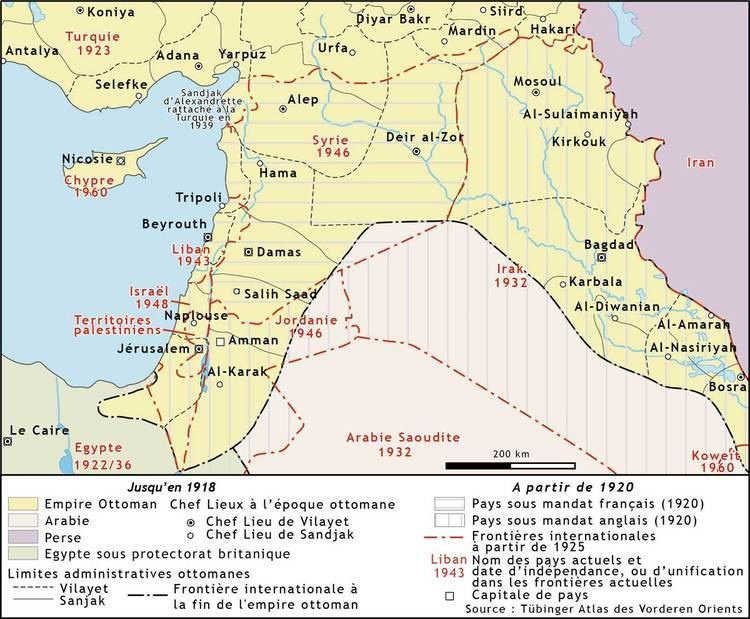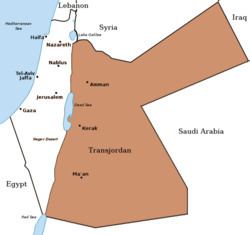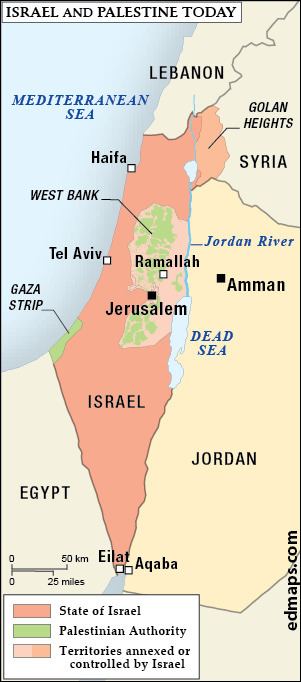Government Monarchy Founded 1921 | Languages Arabic 1924–1939 Henry Fortnam Cox Date dissolved 1946 | |
 | ||
Emirate of transjordan
The Emirate of Transjordan (Arabic: إمارة شرق الأردن Imārat Sharq al-Urdun), also hyphenated as Trans-Jordan and previously known as Transjordania or Trans-Jordania, was a British protectorate established in April 1921. There were many urban settlements beyond the Jordan River, one in Al-Salt city and at that time the largest urban settlement east of the Jordan River. There was also a small Circassian community in Amman.
Contents
- Emirate of transjordan
- Background
- Establishment of British control
- Hashemite Emirate
- Independence and establishment of Hashemite kingdom
- Status of Transjordan
- References

Transjordan had been a no man's land following the July 1920 Battle of Maysalun, and the British in neighbouring Mandatory Palestine chose to avoid "any definite connection between it and Palestine" until a March 1921 conference at which it was agreed that Abdullah bin Hussein would administer the territory under the auspices of the British Mandate for Palestine with a fully autonomous governing system.

The Hashemite dynasty ruled the protectorate, as well as the neighbouring Mandatory Iraq. On 25 May 1946, the Emirate became the "Hashemite Kingdom of Transjordan", achieving full independence on 17 June 1946 when in accordance with the Treaty of London ratifications were exchanged in Amman. In 1949 the country's official name was changed to the "Hashemite Kingdom of Jordan".

Background

Under the Ottoman Empire, most of Transjordan was part of the Syria Vilayet. The inhabitants of northern Transjordan had traditionally associated with Syria, and those of southern Transjordan with the Arabian Peninsula.

During World War I, Transjordan saw much of the fighting of the Arab Revolt against Ottoman rule. Assisted by the British army officer T. E. Lawrence, the Sharif of Mecca Hussein bin Ali led the successful revolt which contributed to the Ottoman defeat and breaking up of its empire.
Establishment of British control
In the secret Sykes–Picot Agreement of 1916, Transjordan was allocated to Britain.

In March 1920, the Hashemite Kingdom of Syria was declared by Faisal I of Iraq in Damascus which encompassed most of what later became Transjordan. At this point, the southern part of Transjordan was part of the Hashemite Kingdom of Hejaz. Following the provision of mandate to France and Britain at the San Remo conference in April, the British appointed a High Commissioner in Palestine with a remit over the area west of the Jordan, and the French ended the Kingdom of Syria at the battle of Maysalun. Transjordan became, for a short time, a no man's land.
In August 1920, Sir Herbert Samuel's request to extend the frontier of British territory beyond the River Jordan and to bring Transjordan under his administrative control was rejected. The British Foreign Secretary, Lord Curzon, proposed instead that British influence in Transjordan should be advanced by sending a few political officers, without military escort, to encourage self-government and give advice to local leaders in the territory. Following Curzon's instruction Samuel set up a meeting with Transjordanian leaders where he presented British plans for the territory. The local leaders were reassured that Transjordan would not come under Palestinian administration and that there would be no disarmament or conscription. Samuel's terms were accepted, he returned to Jerusalem, leaving Captain Alec Kirkbride as the British representative east of the Jordan until the arrival on 21 November 1920 of Abdullah, the brother of recently deposed king Faisal, who marched into Ma'an at the head of an army of 300 men. Without facing opposition Abdullah and his army had effectively occupied most of Transjordan by March 1921.
In early 1921, prior to the convening of the Cairo Conference, the Middle East Department of the Colonial Office set out the situation as follows:
Distinction to be drawn between Palestine and Trans-Jordan under the Mandate. His Majesty's Government are responsible under the terms of the Mandate for establishing in Palestine a national home for the Jewish people. They are also pledged by the assurances given to the Sherif of Mecca in 1915 to recognise and support the independence of the Arabs in those portions of the (Turkish) vilayet of Damascus in which they are free to act without detriment to French interests. The western boundary of the Turkish vilayet of Damascus before the war was the River Jordan. Palestine and Trans-Jordan do not, therefore, stand upon quite the same footing. At the same time, the two areas are economically interdependent, and their development must be considered as a single problem. Further, His Majesty's Government have been entrusted with the Mandate for "Palestine". If they wish to assert their claim to Trans-Jordan and to avoid raising with other Powers the legal status of that area, they can only do so by proceeding upon the assumption that Trans-Jordan forms part of the area covered by the Palestine Mandate. In default of this assumption Trans-Jordan would be left, under article 132 of the Treaty of Sèvres, to the disposal of the principal Allied Powers. Some means must be found of giving effect in Trans-Jordan to the terms of the Mandate consistently with "recognition and support of the independence of the Arabs".
The Cairo Conference of March 1921 was convened by Winston Churchill, then Britain's Colonial Secretary. With the mandates of Palestine and Iraq awarded to Britain, Churchill wished to consult with Middle East experts. At his request, Gertrude Bell, Sir Percy Cox, T. E. Lawrence, Sir Kinahan Cornwallis, Sir Arnold T. Wilson, Iraqi minister of war Jaʿfar alAskari, Iraqi minister of finance Sasun Effendi (Sasson Heskayl), and others gathered in Cairo, Egypt. An additional outstanding question was the policy to be adopted in Transjordan to prevent anti-French military actions from being launched within the allied British zone of influence. The Hashemites were Associated Powers during the war, and a peaceful solution was urgently needed. The two most significant decisions of the conference were to offer the throne of Iraq to emir Faisal ibn Hussein (who became Faisal I of Iraq) and an emirate of Transjordan (now Jordan) to his brother Abdullah ibn Hussein (who became Abdullah I of Jordan). The conference provided the political blueprint for British administration in both Iraq and Transjordan, and in offering these two regions to the sons of Hussein bin Ali, Churchill stated that the spirit, if not the letter, of Britain's wartime promises to the Arabs might be fulfilled. After further discussions between Churchill and Abdullah in Jerusalem, it was mutually agreed that Transjordan was accepted into the mandatory area as an Arab country apart from Palestine with the proviso that it would be, initially for six months, under the nominal rule of the emir Abdullah and that it would not form part of the Jewish national home to be established west of the River Jordan. Abdullah was then appointed Emir of the Transjordania region in April 1921.
On 21 March 1921, the Foreign and Colonial office legal advisers decided to introduce Article 25 into the Mandatory Palestine, which brought Transjordan under the mandate and stated that in that territory, Britain could 'postpone or withhold' those articles of the Mandate concerning a Jewish national home. It was approved by Curzon on 31 March 1921, and the revised final draft of the mandate (including Transjordan) was forwarded to the League of Nations on 22 July 1922. In August 1922, the British government presented a memorandum to the League of Nations stating that Transjordan would be excluded from all the provisions dealing with Jewish settlement, and this memorandum was approved by the League on 12 August.
Abdullah established his government on 11 April 1921. Britain administered the part west of the Jordan as Palestine, and the part east of the Jordan as Transjordan. Technically they remained one mandate, but most official documents referred to them as if they were two separate mandates. In May 1923 Transjordan was granted a degree of independence with Abdullah as ruler and St John Philby as chief representative.
Transjordan remained under British control until the first-Transjordanian treaty was concluded in 1928. Transjordan became nominally independent, although the British still maintained a military presence and control of foreign affairs and retained some financial control over the kingdom. This failed to respond to Transjordanian demands for a fully sovereign and independent state, a failure that led to widespread disaffection with the treaty among Transjordanians, prompting them to seek a national conference (25 July 1928), the first of its kind, to examine the articles of the treaty and adopt a plan of political action.
The borders and territory of Transjordan were not determined until after the mandate came into effect. The borders in the east of the country were designed so as to aid the British in building an oil pipeline from their mandate of Iraq through Transjordan to seaports in the Mandatory Palestine. The strategically important southern section with an outlet to the Red Sea were incorporated into Transjordan by Abdullah, the provinces of Ma'an and Aqaba from the Kingdom of Hejaz in 1925.
Hashemite Emirate
The Hashemite emir Abdullah, elder son of Britain's wartime Arab ally Hussein bin Ali was placed on the throne of Transjordan. The applicable parts of the Mandatory Palestine were recited in a decision of 16 September 1922, which provided for the separate administration of Transjordan. The government of the territory was, subject to the mandate, formed by Abdullah, brother of King Faisal I of Iraq, who had been at Amman since February 1921. Britain recognized Transjordan as an independent government on 15 May 1923, and gradually relinquished control, limiting its oversight to financial, military and foreign policy matters. This affected the goals of Revisionist Zionism, which sought a state on both banks of the Jordan. The movement claimed that it effectively severed Transjordan from Palestine, and so reduced the area on which a future Jewish state in the region could be established.
The most serious threats to Abdullah's position in Transjordan were repeated Wahhabi incursions by the Ikhwan tribesmen from Najd in modern Saudi Arabia into southern parts of his territory. The emir was powerless to repel those raids by himself, and had to appeal for help to the British who maintained a military base with a small air force at Marka, close to Amman. The British military force was the primary obstacle against the Ikhwan between 1922–1924, and was also utilized to help Abdullah with the suppression of local rebellions at Kura, and later by Sultan Adwan, in 1921 and 1923 respectively.
Independence and establishment of Hashemite kingdom
On 17 January 1946, Ernest Bevin the British Foreign Secretary, announced in a speech at the General Assembly of the United Nations, that the British Government intended to take steps in the near future to establish Transjordan as a fully independent and sovereign state. The Treaty of London was signed by the British Government and the Emir of Transjordan on 22 March 1946 as a mechanism to recognise the full independence of Transjordan upon ratification by both countries parliaments. Transjordan's impending independence was recognized on April 18, 1946 by the League of Nations during the last meeting of that organization. On 25 May 1946 the Transjordan became the "Hashemite Kingdom of Transjordan" when the ruling 'Amir' was re-designated as 'King' by the parliament of Transjordan on the day it ratified the Treaty of London. 25 May is still celebrated as independence day in Jordan although officially the mandate for Transjordan ended on June 17, 1946 when in accordance with the Treaty of London the ratifications were exchanged in Amman and Transjordan gained full independence. In 1949 the country's official name was changed to the "Hashemite Kingdom of Jordan".
When King Abdullah applied for membership in the newly formed United Nations, his request was vetoed by the Soviet Union, citing that the nation was not "fully independent" of British control. This resulted in another treaty in March 1948 with Britain in which all restrictions on sovereignty were removed. Despite this, Jordan was not a full member of the United Nations until December 14, 1955.
The Anglo-American treaty, also known as the Palestine Mandate Convention, permitted the US to delay any unilateral British action to terminate the mandate. The earlier proclamation of the independence of Syria and Lebanon had said "the independence and sovereignty of Syria and Lebanon will not affect the juridical situation as it results from the Mandate Act. Indeed, this situation could be changed only with the agreement of the Council of the League of Nations, with the consent of the Government of the United States, a signatory of the Franco-American Convention of 4 April 1924".
The U.S. adopted the policy that formal termination of the mandate with respect to Transjordan would follow the earlier precedent established by the French Mandate for Syria and the Lebanon. That meant termination would generally be recognized upon the admission of Transjordan into the United Nations as a fully independent country. Members of the U.S. Congress introduced resolutions demanding that the U.S. Representative to the United Nations be instructed to seek postponement of any international determination of the status of Transjordan until the future status of Palestine as a whole was determined. The U.S. State Department also received a legal argument from Rabbis Wise and Silver objecting to the independence of Transjordan. At the 1947 Pentagon Conference, the U.S. advised Great Britain it was withholding recognition of Transjordan pending a decision on the Palestine question by the United Nations. The United Nations General Assembly adopted a plan for the future government of Palestine which called for termination of the Mandate not later than 1 August 1948.
The works of Benny Morris, Avi Shlaim, Ilan Pappe, Mary Wilson, Eugene Rogan, and other historians outline a modus vivendi agreement between Abdullah and the Yishuv. Those works are taught in most Israeli university courses on the history, political science, and sociology of the region. Archival materials reveal that the parties had negotiated the non-belligerent partition of Palestine between themselves, and that initially they had agreed to abide by the terms of the UN resolution. John Baggot Glubb, the commander of the Arab Legion, wrote that British Foreign Secretary Bevin had given the green light for the Arab Legion to occupy the territory allocated to the Arab state. The Prime Minister of Transjordan explained that Abdullah had received hundreds of petitions from Palestinian notables requesting protection upon the withdrawal of the British forces. Eugene Rogan says that those petitions, from nearly every town and village in Palestine, are preserved in "The Hashemite Documents: The Papers of Abdullah bin al-Husayn, volume V: Palestine 1948 (Amman 1995)".
After the mandate was terminated, the armed forces of Transjordan entered Palestine. The Security Council adopted a US-backed resolution that inquired about the number and disposition of Transjordan's armed forces in Palestine. The Foreign Minister of Transjordan replied in a telegram "that neither the UN nor US recognized Transjordan, although they both had been given the opportunity for more than two years. Yet the US had recognized the Jewish state immediately, although the factors for this recognition were lacking."
Abdullah explained Transjordan's armed forces entry into Palestine to the Security Council saying "we were compelled to enter Palestine to protect unarmed Arabs against massacres similar to those of Deir Yassin."
After capturing the West Bank during the 1948 Arab–Israeli War, Abdullah was proclaimed King of Palestine by the Jericho Conference. The following year, Jordan annexed the West Bank.
The United States extended de jure recognition to the government of Transjordan and the government of Israel on the same day, 31 January 1949. Clea Bunch said that "President Truman crafted a balanced policy between Israel and its moderate Hashemite neighbours when he simultaneously extended formal recognition to the newly created state of Israel and the Kingdom of Transjordan. These two nations were inevitably linked in the President's mind as twin emergent states: one serving the needs of the refugee Jew, the other absorbing recently displaced Palestinian Arabs. In addition, Truman was aware of the private agreements that existed between Jewish Agency leaders and King Abdullah I of Jordan. Thus, it made perfect sense to Truman to favour both states with de jure recognition."
In 1978, the U.S. State Department published a memorandum of conversation between Mr. Stuart W. Rockwell of the Office of African and Near Eastern Affairs and Abdel Monem Rifai, a Counselor of the Jordan Legation on 5 June 1950. Mr. Rifai asked when the United States was going to recognize the union of Arab Palestine and Jordan. Mr. Rockwell explained the Department's position, stating that it was not the custom of the United States to issue formal statements of recognition every time a foreign country changed its territorial area. The union of Arab Palestine and Jordan had been brought about as a result of the will of the people and the US accepted the fact that Jordanian sovereignty had been extended to the new area. Mr. Rifai said he had not realized this and that he was very pleased to learn that the US did in fact recognize the union.
Jordan was admitted as a member state of the United Nations on 14 December 1955.
Status of Transjordan
According to the U.S. State Department Digest of International Law, the status of the mandate was not altered by the agreement between the United Kingdom and the Emirate concluded on 20 February 1928 which recognized the existence of an independent government in Transjordan and defined and limited its powers. The ratifications were exchanged on 31 October 1929."
In 1937, the US Consul General at Jerusalem reported to the State Department that the Mufti refused the principle of partition and declined to consider it. The Consul said the emir Abdullah urged acceptance on the ground that realities must be faced, but wanted modification of the proposed boundaries and Arab administrations in the neutral enclave. The Consul also noted that Nashashibi sidestepped the principle, but was willing to negotiate for favourable modifications.
Transjordan applied for membership of the United Nations on 26 June 1946. The Polish representative said that he did not object to the independence of Transjordan, but requested that the application be postponed for a year on the grounds that legal procedures required by the Covenant of the League of Nations had not been carried out. The British representative responded that the League of Nations had already approved the termination of the mandate in Transjordan. When the issue was voted on, Transjordan's application achieved the required total number of votes, but was vetoed by the Soviet Union which did not approve membership of any countries with which it did not have diplomatic relations. This problem and similar problems caused by vetoes of the memberships of Ireland, Portugal, Austria, Finland and Italy took several years and many votes to solve. Jordan was finally admitted to membership on 14 December 1955.
